All you need to know about your products!

| 3DNews Vendor Reference English Resource - All you need to know about your products! |
||||||
 |
||||||
|
|
||||||
CeBIT 2008: ASUS' expo standAuthor:Date: 22/03/2008 ASUS' expo standAs we already reported, the right motor cars are at ASUS' expo stand. In particular, this is Gallardo, the lower-end model in the Lamborghini family.  Whether its by accident or not, but ASUS presented the lower-end notebook of the Lambo series with a 12" screen. 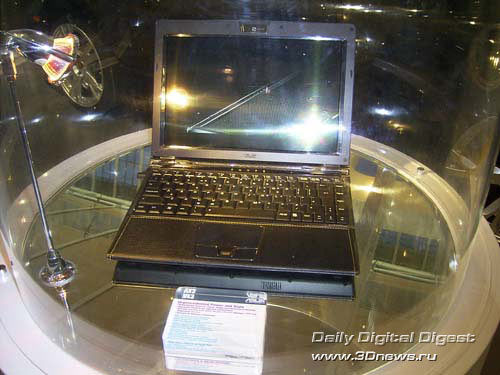 Along with the new notebook, there has been planned a release of accompanying accessories like carrying bags, mice, and the external keyboard.  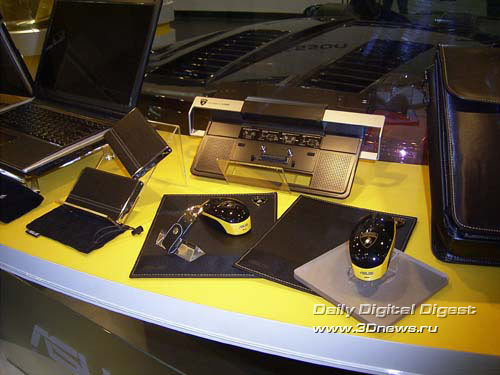  Besides, at the expo stand we notice notebooks under the Lambo mark of the previous series,  as well as the absolutely new communicator ZX1. 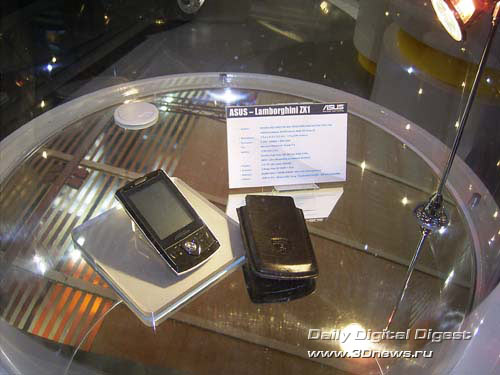 This mobile device offers a 450 MHz CPU, 128 MB SDRAM (+254 MB integrated Flash-memory), 2.8" TFT-screen of 320?240 (65K colors) resolution, a 3 MP camera, as well as an integrated GPS receiver. The communicator is equipped with a 1150 mA*hr battery and is powered by Windows Mobile. Interestingly, ASUS is launching a whole series of GPS navigators under its trade mark. This is the model R700T (4.3" TFT sensor display of 480x272 resolution) 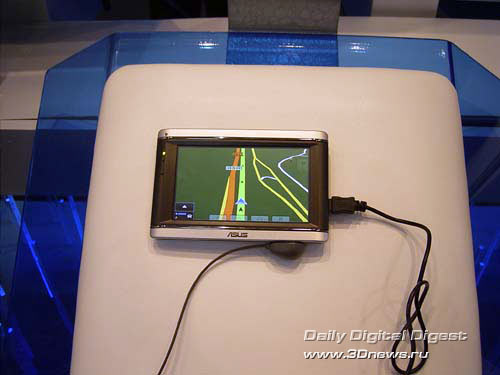 and the cheaper R300T (3.5", 320?240). 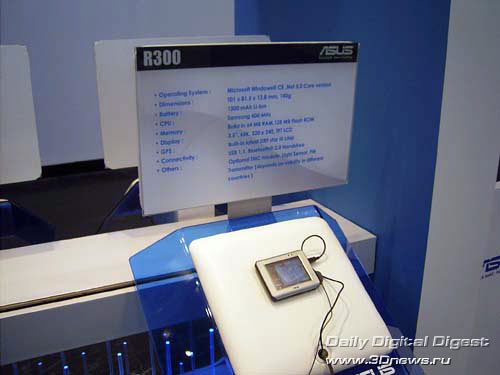 There was also presented the concept device ASUS R70 which is a heir to the previous R series and the Hermes concept.  The question is if R70 finally arrives at retail shelves or will be replaced with another concept. ASUS has substantially renovated the already wide assortment of motherboards. In particular, at the expo stand there was displayed the Crosshair 2 motherboard based on NVIDIA 780a SLI with support for DDR2-1066 and three PCI Express x16 slots. At the same time, this board offers the integrated graphic core and support for the Hybrid SLI technology. 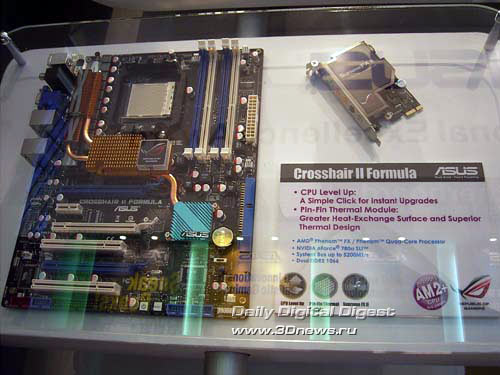 In due time, we recognized ASUS Crosshair as the best motherboard for AM2, and it is really interesting to see if the heir is able finding itself at the same level. Another interesting motherboard is called Maximus II Extreme and is based on the most recent Intel P45 chipset. Amusingly, the previous Maximus model is based on the top-end X38 chipset and it would be logical to assume that Maximus II would be based on X48. But no - the new board is based on the middle-end Intel P45 chipset.  This model relates to the Republic of Gamers series and is one of the most advanced of all ASUS' motherboards based on P45. It offers a powerful system for cooling the chipset with the integrated water-block (it would be interesting to see the level of heat emission for P45). The remaining boards based on P45 don't look as impressive but cost much cheaper at the same time. The new series of these motherboards has been named P5Q, and by analogy with P35/X38, the model name points to the type of supported memory. For instance, P5Q-Deluxe supports DDR2,  and P5Q3-Deluxe/WiFi is aimed at operation with DDR3 and also supports Wi-Fi.  By the ration between P45-based models that support DDR2 and DDR3, we make the conclusion that DDR3 is not going to be popular for at least end of the year. In particular, ASUS offers three motherboards which support DDR2, and only one that supports DDR3. P5Q-E is the cheaper version of P5Q-Deluxe and is based on the same PCB design. Therefore, the differences in price and functionality will be extremely negligible. 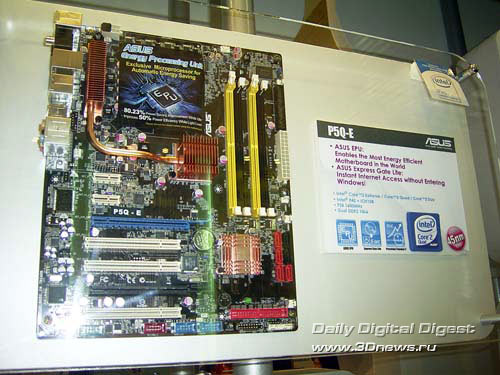 That can't be said about the P5Q. This is the weakest and cheapest model built on the P45, and it has its own PCB design, with the ICH10 chip used as the south bridge. 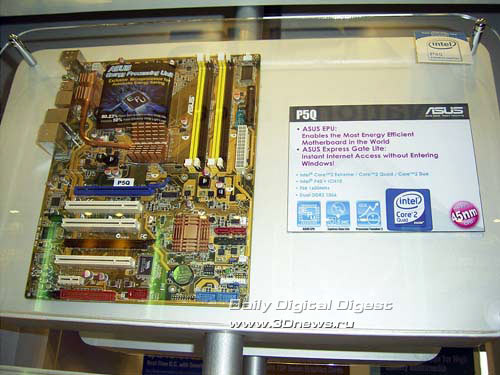 The same chip is also installed on P5QC which is interesting for its support for both DDR2 and DDR3 (recall that simultaneous operation of different memory types is not possible). 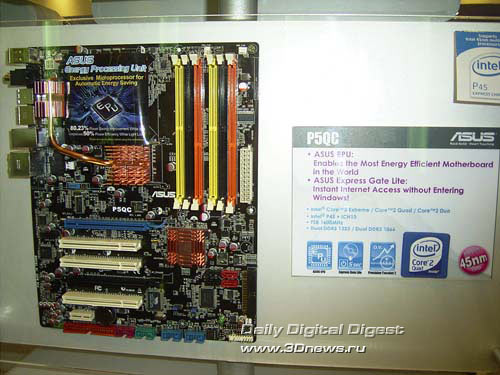 All the other motherboards based on P45 in question are equipped with the more expensive and functional ICH10R chip. At the same time, ASUS Rampage Formula is based on X48 and offers the ICH9R chip. 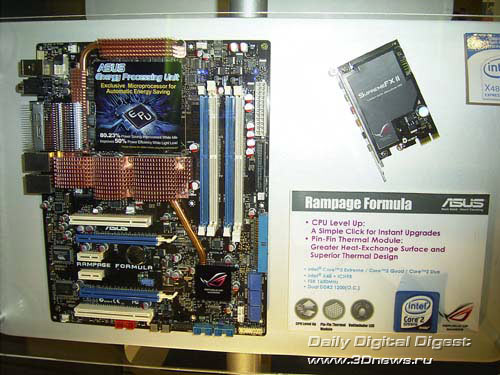 To all appearances, the difference between ICH10R and ICH9R are so minor that the developers use the most suitable. However, there is the impression that the Rampage model is interim one released in order to include at least one motherboard based on X48 into the assortment. Frankly, it does not look like other top-end motherboards of the Republic Of Gamers series. See for yourselves: there are merely two PCI Express x16 slots with no integrated water-block. Whereas the regular model based on X38 - P5E3 Premium/WiFi@n - offers as powerful cooling system and three PCI-E x16 slots.  However, this model can't be talked of as commonplace because it offers support for the Wi-Fi of IEEE 802.11 "n" specification, which provides a bandwidth at about 300 Mbit/s. Moreover, this motherboard supports two independent access points. Interestingly, the Wi-Fi unit is removable and is installed on the rear panel of the board. A block precisely like that will be used to equip new batches of motherboards of the P5E(3) series, namely, those which supported Wi-Fi "g/b". Nor NVIDIA chipsets have been forgotten. In particular, ASUS presented the Striker II Extreme model based on NForce 790i Ultra SLI (the dual-chip architecture).  We have already got one Striker II at our test lab, but that is the Formula modification which is based on the nForce 780i SLI chipset (the triple-chip architecture). Somewhere deep in the hutches of the ASUS's expo stand, there must be hidden the Striker II NSE motherboard based on the NForce 790i SLI chipset (not Ultra). However, it was not demonstrated to journalists. One of the demo systems was showing the strength and might of the triple SLI (3-Way SLI): 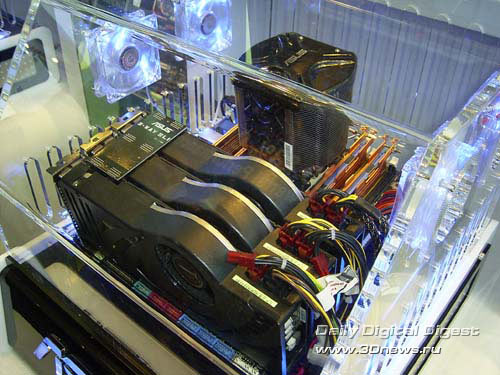 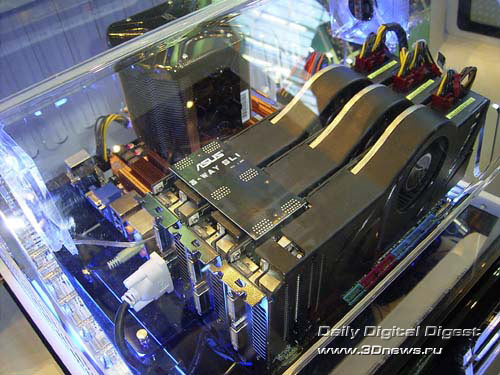  Note the really powerful system for cooling the chipset and the memory modules. Additional radiators of the latter are interlinked with the system by means of heat pipes. This block is removable and has a special name - the Memphite. In other words, you purchase a M3N-HT Deluxe based on NVIDIA NForce 780a SLI,  and then, if necessary, install a separate Mempipe block (you can clearly see the attachment points for its fastening). If this block is shipped as a bundled item with this board, the name Mempipe will be added to the name of the motherboard. 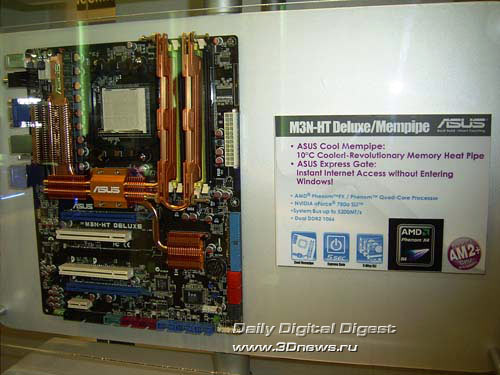 The same Mempipe block can be installed on several other boards, in particular, M3A32-MVP Deluxe which is based on AMD 790FX. The chipset itself is not a novelty, and the south bridge SB600 is old enough. 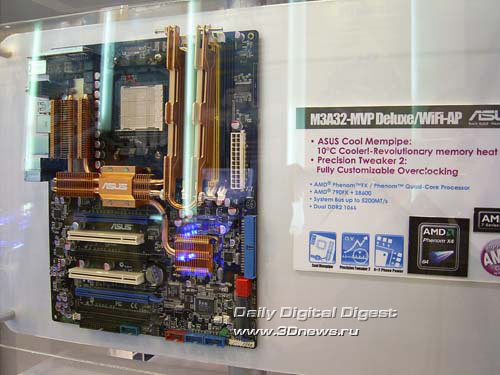 However, at Cebit 2008 AMD presented the new south bridge SB700, and this chip is already used in a number of motherboards, for instance, on M3A-H HDMI which is based on the integrated AMD 780G chipset: 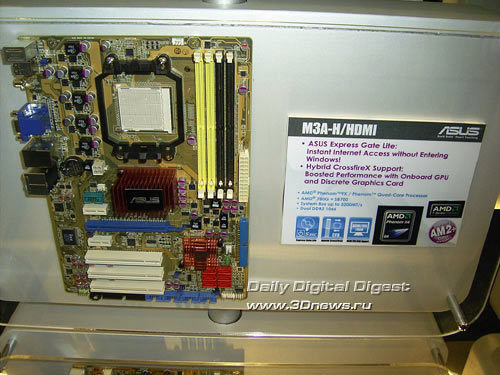 There were a lot of motherboards on integrated chipsets. These are M3N-H HDMI (GeForce 8300) with support for ASUS Express Gate Lite (connection to the Internet without booting the OS), as well as the HyperSLI 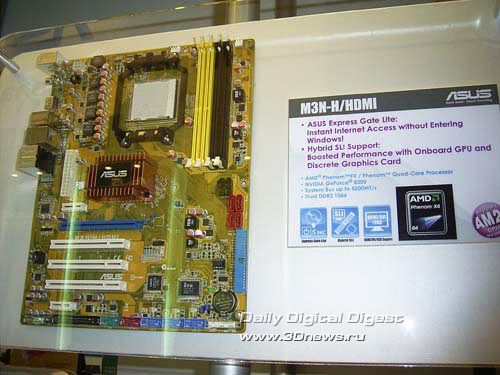 M3N-HD HDMI (NForce 750a SLI) (with support for the same technologies), and P5Q-V HDMI based on the combination Intel G45 + ICH10R (ASUS EPU + Express Gate Lite) 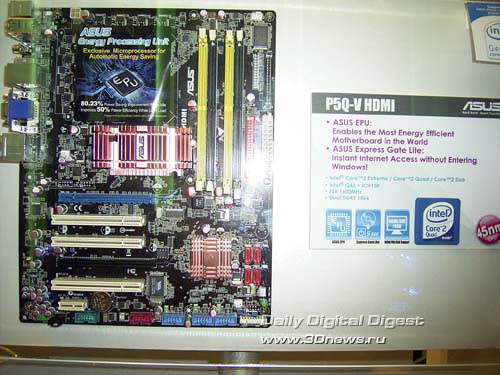 In general, the progress in the field of cooling systems for motherboard components is clearly seen to the named eye. Of special interest is the concept model ASUS PINOTNOIR. 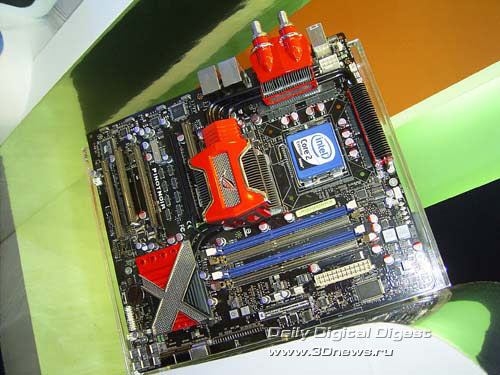 Since that is a concept model, we are not at all interested in the specifications of this board as well as its performance. What matters is that ASUS managed to provide all the key components of the motherboard with water-powered cooling, in particular, north and south bridges.  Moreover, the fluid-cooling radiators are installed on the power supply components of the power converter (of the new generation). 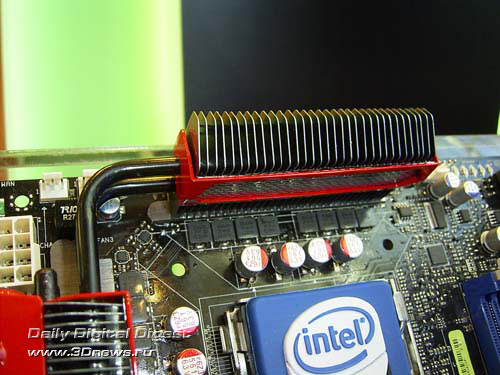 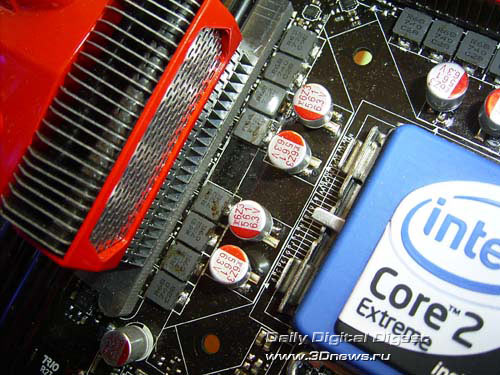 One of the water-blocks (just the one installed on the PWM) has two connection pipes to plug in a water-powered cooling system. 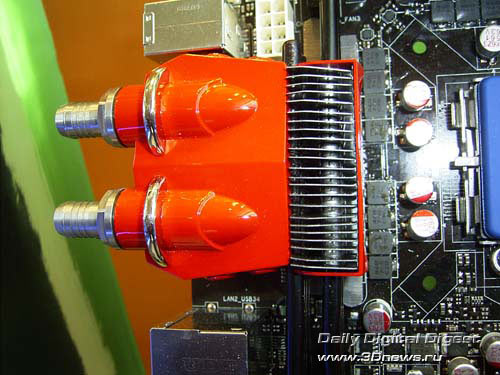 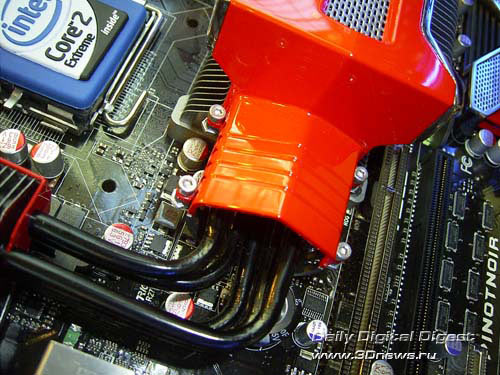 So, we are anxiously looking forward to the the first retail boards with such a system of water-powered cooling. Another concept model appears to be a really huge housing which is styled to transformers from the film with the same name. The system is called ARES, and its major trait is in that is a fully configured gaming computer with three video cards merged into a 3-Way SLI, that costs at least $10.000! 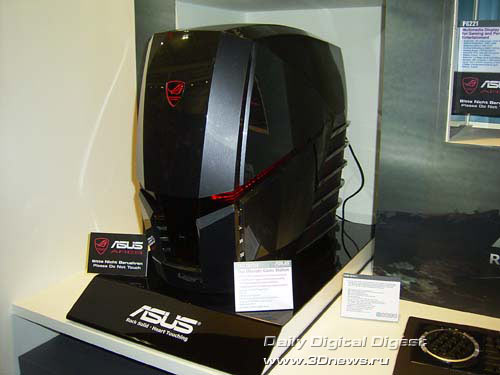 Then, ASUS is bringing in a series of high-performance gaming notebooks.  The model G2Sg with the CPU T9500-T8100, integrated video card NVIDIA GeForce 8700M GT (512 MB GDDR3); the 17" screen, and therefore the weight - 4.4 kg. 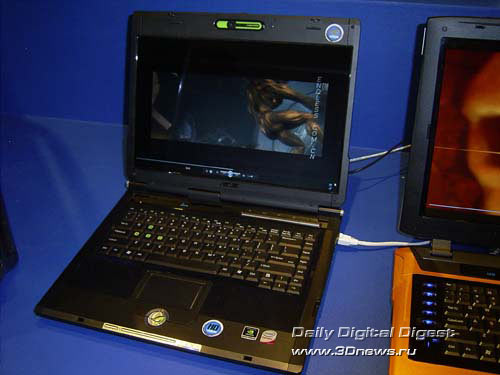 The next model is more powerful, heavier and more costly. The notebook is called G70, can be equipped with a quad-core X9000 CPU. The key trait is in that the video subsystem made of two NVIDIA GeForce 8700GS chips merged following the SLI technology of the overall video memory capacity as high as 1 GB! 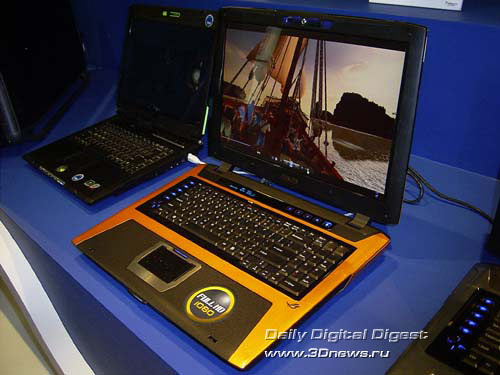 There is also one more modification G70, in a more strict housing.  In conclusion, we mention the new line of ASUS monitors,  one of which - 22" VK222H is equipped with a "nondestructive" screen. To all appearances, this is also a concept model, since ASUS representatives did not allow to try this property in action.  At the expo stand, we also notice several new ASUS coolers, among the most interesting of which is called Triton 79 with a 12-cm fan and a gilt upper lid. 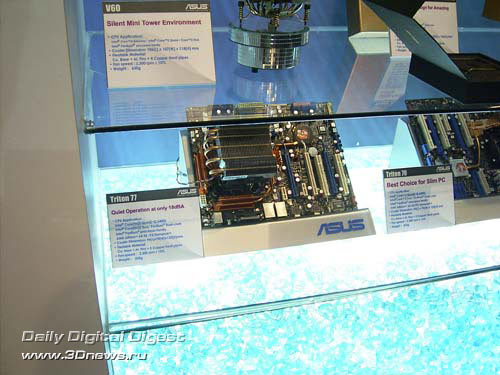  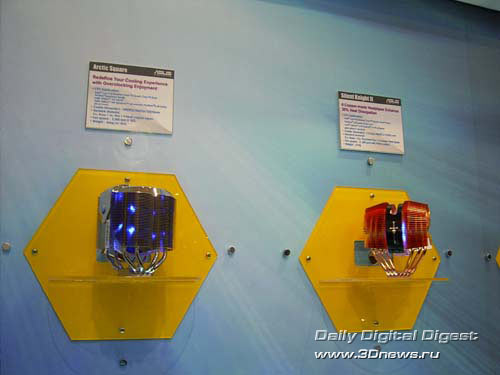 Besides, in quite an everyday way ASUS announced the release of fully assembled desktops under its own trademark: 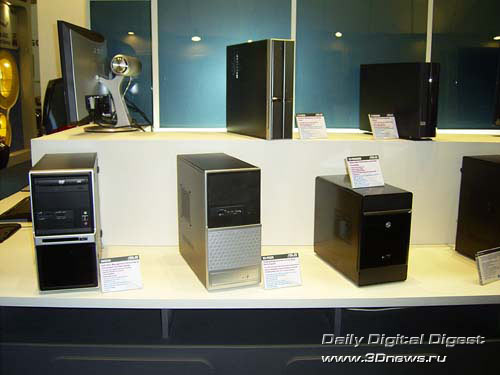  Apart from the large number of similarly gloomy square housings, ASUS presented a $200-worth Desktop PC in quite an attractive attire: 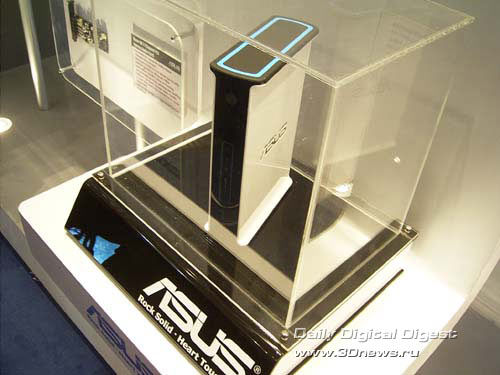 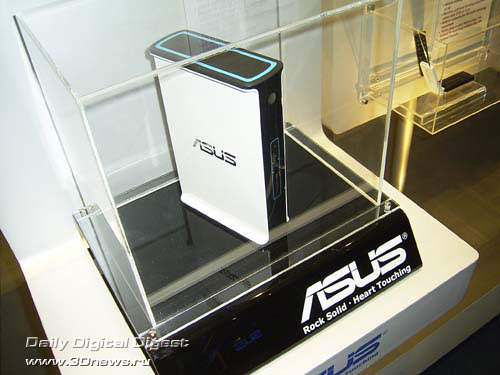 In conclusion, we note the fact which gives a positive image of ASUS: on the first day of the expo, the really beautiful motor car was joined by as beautiful girls. 
- Discuss the material in the conference
|
|
|||||